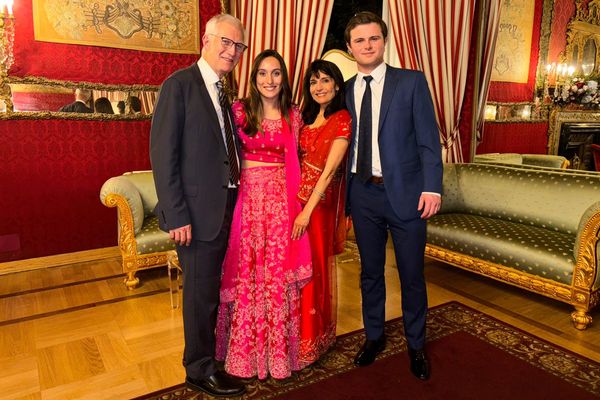
Maseru, Lesotho – On a sunny afternoon, a white minibus taxi carrying 22 passengers pulled out of a crowded bus station in Johannesburg and headed to neighbouring Lesotho, the landlocked kingdom inside South Africa’s borders.
The moment the minibus got on the highway, the driver switched on the radio and the speakers crackled to life with the sound of a solo accordion – the intro to a well-known Famo song.
“I could listen to this music all day,” said one passenger, a young man in blue workman overalls, but worn stylishly to make a fashion statement instead of for industrial use. Around him, many other passengers, most Lesotho nationals, bobbed their heads and sang along as the drums and vocals on the track kicked in.
Famo, a genre of music that blends traditional Southern African songs and Western instruments, first emerged a century ago among migrant mining communities in South Africa. The music, characterised by heavy use of the accordion fused with guitar picking from the maskandi style, a subgenre of Zulu folk music, is greatly loved by many Basotho.
But in recent years, Famo has become notorious beyond dance halls and concert venues. Fierce rivalry between some fans and singers has caused deadly gang warfare in Lesotho. Recently, the violence has exacerbated so much that the government banned some Famo groups and branded them “terrorist” organisations.
Now many die-hard fans are unable to watch their favourite artists perform live. “I love Famo music,” says Thabelo, a taxi driver in Maseru who we are not naming as many people are now nervous to speak publicly about the topic. “You know they have banned the shows now, so we can only play it in our cars or in the privacy of our homes.”
The ban, which went into effect in May, named specific Famo groups which the government called “unlawful by reason of being involved in, or promoting or encouraging subversive activities”. The ban extends to any paraphernalia associated with banned groups, such as stylish traditional blankets with distinct gang colours.
Some of the groups banned include the popular Terene ea Chakela and Terene ea Mokata-Lirope, among others.
However, groups or musicians not affected by the ban are free to perform, like Famo artist Mantsali Julia Hantsi, popularly known as Thope Tse Khang.
Famo music wasn’t always associated with violence and gangs, Hantsi told Al Jazeera, adding that historically, Famo music was a way for people to express themselves, celebrate, and tell stories.
“[Famo music] was a form of entertainment that also served to preserve the history and culture of the Basotho people,” she said. “Unfortunately, in more recent times, certain factions have used the music to incite violence or promote rivalry among themselves.”

‘Not about violence’
In July this year, two prominent voices at the forefront of the Famo scene were caught up in the worsening violence when unidentified gunmen opened fire on their van in Maseru and shot them.
Khopolo Khuluoe, popularly known as Lisuoa, was an award-winning singer of Famo, while Pulane Macheli was a celebrated radio personality. Together, they were on a quest to stop violence related to Famo music.
Instead, they became victims of the very thing they were trying so hard to stop – with Khuluoe killed instantly at the scene of the shooting and Macheli dying in hospital the following day.
In Lesotho, murders related to Famo music seem to have risen. This year alone, the media has reported several cases of Famo-related murders, including the family members of an alleged Famo gangster.
Many of the killings are connected to a longstanding feud between two major Famo gangs: the Terene ea Mokata Lirope group, and the Liala Mabatha gang. The two have been at each other’s throats for months.
In April, two members of the Terene group were shot at a funeral in their leader’s rural home in Leribe. Six hours later, a suspected revenge killing took place: five family members of a rival Famo gang member were killed.
No one has been charged for the murders but it is believed the killings are linked to the Terene and Liala Mabatha feud.
Hantsi feels disheartened about the new associations between Famo and violence. “This shift has cast a shadow on the genre,” she said, “but at its core, Famo is not about violence; it’s about storytelling and expression.”

Evolution of Famo
Famo music originated in the slum yards of Johannesburg in the 1920s, writes Lehlohonolo Phafoli in the academic article The Evolution of Sotho Accordion Music in Lesotho. Back then, it was mostly performed for drinkers of an illicit brew called “skokiaan” in illegal drinking spots for Black people, called “shebeens”.
Many visiting the shebeens, according to Phafoli, were Basotho nationals who joined throngs migrating to South Africa in search of work, which also included native Black South Africans dispossessed from their land under apartheid.
From South Africa’s townships, Famo made its way to Lesotho. Phafoli notes: “Famo music spilled over into Lesotho and became common in shebeens. Its arrival in Lesotho can be attributed to two major groups: first, migrant labourers, especially men, and second, Basotho women who came from the locations and mine compounds in Johannesburg”.
Over the years, South Africa and Lesotho have continued to share similar, and often connected, crime problems linked to Famo music and illegal mining.
Famo is still popular among the “zama zamas”, the illegal miners who burrow for gold in the remnants of Johannesburg’s old, disused mines and mine dumps today.
At a rest stop between Johannesburg and Maseru, one of the Basotho passengers, Keith Mahosi, points stealthily to the stylish blue overall-clad passenger and Famo fan.
“You see that guy over there, he is a zama zama,” said Mahosi, a financial analyst working in Johannesburg whose real name we are not using to protect his safety.
“If any altercation were to arise right now,” Mahosi said quietly, “he [the man in blue overalls] will be the first to pull out a gun.”
There is much mistrust and apprehension around those suspected of being zama zamas, amid evidence linking them to crime and violence, including murders. Many zama zamas are also thought to be associated with Famo gangs.
Along Lesotho’s border with South Africa, it is generally peaceful – populated with friendly roadside vendors and makeshift zinc structures that serve as bus terminals. But the peace can shift suddenly. On June 11, several gunmen opened fire on passengers as they stepped out of a minibus, killing two people. It is believed the killings were Famo related.
One of the biggest drivers of Famo violence is illegal mining in South Africa, John Mokwetsi, a journalist from Lesotho, told Al Jazeera in Maseru, using a pseudonym to protect his safety.
“These Famo gangs now run different illegal mining turfs in South Africa. What happens is sometimes they [rival Famo gang members] have conflict in the mines. When they fail to locate a gang member they wish to harm in South Africa, they travel to Lesotho and kill the gang member’s family,” he said.
‘Like a rap beef’
In Lesotho today, the gangs formed around Famo music operate in different areas, according to local media reports.
Mahosi, who is a fan of American hip-hop music, likened the feuds of Famo gangs to the US hip-hop feud of the mid-1990s that culminated in the deaths of Tupac Shakur and Christopher Wallace (popularly known as Biggie Smalls). The feud pitted artists from cities on the East Coast of the US against those from the west.
Drawing parallels between the two music feuds, Mahosi said: “Like the rap ‘beef’ between East Coast and West Coast back in the day, here [in Lesotho] we have the north and south with Leribe district being the south and Mafeteng district being the north.
“A Famo musician from the north cannot perform in the south and vice versa. Well, they can but chances are they won’t make it back home alive,” he added.
Originally, some Famo gangs formed to support musical artists in times of sickness and death. Two Famo gangs that were at the centre of violence between 2009 and 2011, Seakhi and Terene, started as burial societies meant to assist members when they lost loved ones.
“The violence started when Famo artists began insulting each other in their music,” said journalist Mokwetsi.
While it is not clear exactly when the violence started, the first spate of Famo violence widely reported on by the press was between 2009 and 2010 when 100 Famo artists were said to have been killed in Lesotho and South Africa.
Famo violence has rapidly increased killings in Lesotho; the country of 2.3 million now has the sixth-highest murder rate in the world.
Hantsi, the budding Famo musician, told Al Jazeera the violence has tarnished the image of the genre. “It’s unfortunate because people now associate the genre with negativity, even though that’s not what it originally represented,” said Hantsi.
“This has made it harder for genuine Famo artists to continue their craft without being caught up in the politics and violence surrounding the genre.”

‘Breeding ground’
For many young men who join Famo gangs, it all starts at initiation school, journalist Mokwetsi told Al Jazeera. Initiation school for boys in Lesotho, also known as Lebollo Labanna, is a rite of passage that involves male circumcision, among other things.
“The initiation schools are sort of a breeding ground for these [Famo] gangs,” said Lerato Ncube, another journalist investigating Famo violence with Mokwetsi, who we are also not naming to protect her identity. Referring to Lesotho’s initiation schools, she said: “That’s where they [Famo gangs] recruit from.”
Famo gangs use money to lure vulnerable youths to join up, Ncube told Al Jazeera. She said they offer young boys in rural areas, many of whom live in tough economic conditions, huge amounts of money with promises of more to come.
“When they recruit you into the gangs, they [Famo gangs] go to your family, they sit your family down to say, we are taking this person, we want this person to work with us. But because the environment is volatile, this person might die. So here is 500,000 [South African rand] or here is 1 million [rand] as insurance so that should this person die, you don’t come complaining to us, we have already paid for his life,” she said.
Since the government banned some Famo groups, at least three men from an area called Leribe in Lesotho have been sentenced to 10 years in jail for wearing regalia of banned Famo groups.
“While I understand the government’s concern for public safety, I believe that banning Famo music and shows is not the solution,” Hantsi told Al Jazeera. She said there should be a focus on addressing the causes of the violence. “Famo music itself is not the problem; it’s how certain individuals have used it to push harmful agendas. Music is meant to unite and heal, and we should work toward restoring that positive role.”
Despite the violence, Hantsi continues to release songs and is currently experimenting with a fusion of Famo and hip-hop. “Hip-hop has a global reach, and its ability to speak on current social issues and personal stories complements Famo’s traditional narrative style. By blending the two genres, I’m able to keep the essence of Famo alive while making it relevant for today’s audience.”

‘They are gangsters’
Famo gangs have also spread their tentacles into various government agencies, Mokwetsi told Al Jazeera. He said Famo gangs have people in Lesotho’s army and police, and some members of the public are now afraid to report Famo activities to police because they fear information will leak and there will be retribution.
Political parties in Lesotho are connected to Famo gangs, Mokwetsi said, something also reported by local media. It has also reported on allegations that the army and police are “in bed” with Famo gangs – claims the army denies.
In May, Lesotho’s acting police commissioner at the time, Mahlape Morai, admitted that Famo gangs had compromised the police force. She pointed out, however, that the police weren’t the only entity dealing with Famo infiltration. “It is not only police officers who have joined Famo gangs. The entire country is embroiled in the Famo gangs perpetrating criminal activities and killing people. Famo is celebrated in Lesotho, crime is celebrated in Lesotho, and for me, it needs to be given attention by everyone, not just the police,” The Lesotho Times quoted her as saying.
On a busy Friday afternoon in the heart of Maseru, Pioneer Mall – one of the biggest shopping centres in the country – was teeming with people. Near the main entrance, people crowded around a mega-sized chess board – many playing music. In surrounding shops, pop and hip-hop streamed through speakers. But one thing conspicuous by its absence was Famo music – a starkly different picture from the dominance of the genre on minibuses plying the Johannesburg-Maseru route.
“Famo is not everyone’s cup of tea,” said Mahosi, who said the genre was more popular in rural Lesotho than in urban centres like Maseru. That’s partly because of taste preferences but also because of the violence now associated with Famo, he said.
“I don’t dislike Famo music,” Mahosi said. “Many people like it because it is our traditional music. But over the years, it has become about violence. Many of the people who sing Famo music are zama zamas, they are gangsters.
“It’s the people associated with Famo music that make me want to disassociate myself with the genre.”







